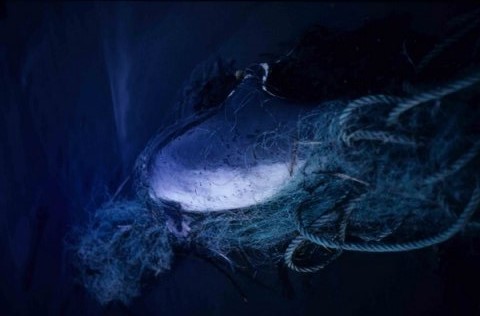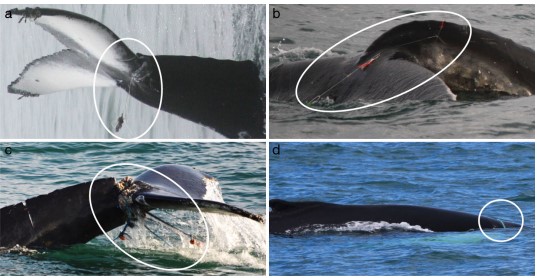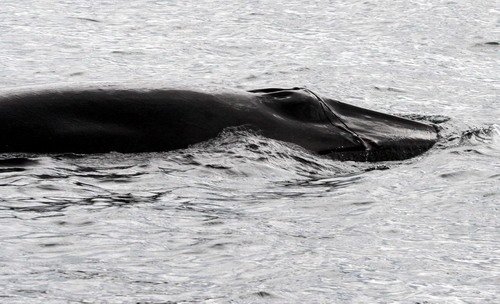Cetacean entanglement is a global issue. Cetaceans of all species can become entangled in active or discarded fishing gear or other marine debris. Animals that are unintentionally caught by active fishing gear are classified as ‘bycatch.’ Those that become wrapped up in abandoned fishing gear are classified as ‘entangled.’ In the U.K, bycatch is the leading cause of death for common dolphins and harbour porpoises.

Along the Icelandic coastline, a study performed by Sea Watch Foundation scientists in collaboration with the staff at the University of Iceland found that 24.8-50.1% of humpback whales had previous entanglements. In another study focusing on humpback whales in the Gulf of Lawrence, researchers found that 85% of photographed humpbacks had entanglement scars. Both of these estimates are conservative due to the fact that entanglement scars are only visible on parts of the body that come out of the water during surfacing, notably dorsal fins and flukes. Therefore, the true proportion of humpback whales that have experienced entanglement may be much higher.

For smaller species, it is difficult to estimate the number of animals that have been entangled during their lifetime. When small cetaceans like harbour porpoises become entangled, the fishing equipment is often too heavy for them and they quickly drown. Larger cetaceans, like humpbacks and minke whales wrapped up in fishing gear can suffer a much slower fate. Depending on where ropes and nets embed themselves along the body, it is possible that a large whale will tow that fishing gear for months. Over time, a fishing rope tightly wound around an animal’s tail could sever the tissue and lead to infection. In addition, the extra energy required to drag heavy fishing gear through the water could take a toll on a whale’s health condition. One study found that entangled right whales survived with an entanglement for an average of 5.6 months before succumbing to their injuries.

Oftentimes cetaceans can untangle themselves from fishing gear. However, one case study of a minke whale shows that lacerations from former entanglement can still be damaging. The minke whale had suffered an entanglement around its ventral pouch, which distends to intake water and food during lunge feeds. While the rope was no longer present, the minke whale distended its pouch 22% less compared to uninjured minke whales. Entanglement injuries that impair feeding ability could have a profound effect on dolphin and whale survival over time.
Although cetacean entanglement is a huge problem, efforts are being made to reduce their frequency. Fisheries are making gear modifications to reduce cetacean bycatch, and have lookouts to ensure marine mammals are not in the area when nets are released.
“As a Sea Watcher, you may be wondering how you can personally help prevent cetacean entanglement. You can report sightings and photos of entangled cetaceans to us using our online sightings form. If the entangled cetacean is in distress or it is not in good condition, please contact the BDLMR.”
Choosing seafood from fisheries with minimal bycatch is another way to support ethical practices and reduce harm to cetaceans. As you enjoy whale-watching from your boat, keep an eye out for marine debris and clean it up if you are able. With enough Sea Watchers doing their part, we can help conserve the lives of these incredible creatures that play an important role in our coastal ecosystem.
Megan
Sea Watch Volunteer
Feature Blogger
Sources
- Basran, C. J., Bertulli, C. G., Cecchetti, A., Rasmussen, M. H., Whittaker, M., & Robbins, J. (2019). First estimates of entanglement rate of humpback whales Megaptera novaeangliae observed in coastal Icelandic waters. Endangered species research, 38, 67-77.
- Kot, B., Ramp, C., & Sears, R. (2009). Decreased feeding ability of a minke whale (Balaenoptera acutorostrata) with entanglement-like injuries. Marine mammal science, 25(3), 706.
- Moore, M. J., Bogomolni, A., Bowman, R., Hamilton, P. K., Harry, C. T., Knowlton, A. R., … & Touhey, K. (2006, September). Fatally entangled right whales can die extremely slowly. In OCEANS 2006 (pp. 1-3). IEEE.
- Ramp, C., Gaspard, D., Gavrilchuk, K., Unger, M., Schleimer, A., Delarue, J., … & Sears, R. (2021). Up in the air: drone images reveal underestimation of entanglement rates in large rorqual whales. Endangered Species Research, 44, 33-44.
- https://wildwhales.org/threats/entanglement/
- https://www.nhm.ac.uk
























